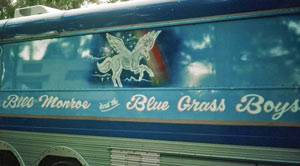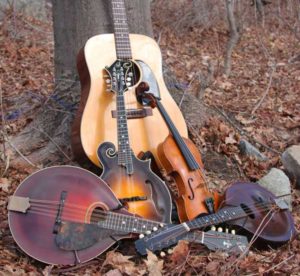- Original Blue Grass Boys
- The Lore of the Loar
- Ecology of Tonewoods: The Roots of the Ancient Tones
- Ancient Tones: American Modal Music
- Monroe’s Time in Asheville
- Musicians and Their Bodies
- Luthier Diagnosis Center
- Fireside Coffee Chats
Original Blue Grass Boys
 Bill Monroe is famous around the world for creating his own personal musical language, the music that eventually became known as “bluegrass.” As it grew over the decades bluegrass music took on many nuances, and we believe one of the largest contributing factors to those changes can be attributed to Monroe’s band, The Blue Grass Boys.
Bill Monroe is famous around the world for creating his own personal musical language, the music that eventually became known as “bluegrass.” As it grew over the decades bluegrass music took on many nuances, and we believe one of the largest contributing factors to those changes can be attributed to Monroe’s band, The Blue Grass Boys.
The Blue Grass Boys numbered nearly 150 members from the band’s beginnings in 1938 until Bill’s last performance in 1996. Many distinguished names are included in the ranks of men (and women) known as “Blue Grass Boys.” They’re some of the most talented and influential individuals to play the genre. Bluegrass may have been conceived by Bill Monroe, but without the creative input and support of the Blue Grass Boys he would not have been able to achieve the body of work he left for us.
We are excited to present to you several of Bill Monroe’s greatest—and enduring—sidemen. They are Byron Berline, Bob Black, Bobby Hicks (tentative), Mike Bub, Mark Hembree.
You don’t want to miss this special all-camp presentation. This is a group of not only great musicians, but also conscientious historians of the music. Look forward to insights into the inner workings of the band and how they strove to support Monroe’s vision, as well as their contributing renditions of the music they played with Bill. There are sure to be plenty of anecdotes about road life as well.
The Mandolins of Bill Monroe: The Lore of the Loar
Presented by Tom Isenhour. Bringing a 1923 F5 cut from the same tree as Monroe’s, as well as other instruments Monroe played, Tom Isenhour is going to talk about why Monroe chose the Loar F5 as his instrument, and particularly, Lloyd Loar’s signature model instrument and history. Come with your questions, and to experience up close and personal, these historic instruments!
Ecology of Tonewoods: The Roots of the Ancient Tones
 Presented by Eco-Musicologist, Bill Hamilton. In his description of Bluegrass music, Bill Monroe once spoke of his use of “ancient tones,” or the sounds of pipe and fiddle music that originated in the British Isles and made their way to the hills and hollows of Appalachia and the American southeast. But what happens if we consider how the tone and feel of the High Lonesome Sound also has roots in natural history that can be attributed to the native ecology of the United States? Join eco-musicologist Bill Hamilton in the investigation and discovery of how ecological growing conditions and specific tree species commonly found in the forested communities of the Northeast United States contributed to the tonality, emergence and continued development of an American music genre. Between an interpretive woods walk on which you will learn to read the landscape and identify notable tree species and interactive exhibits through which you will handle and observe the properties of different samples of tonewood, we invite you to develop a new appreciation for the meaning of roots music.
Presented by Eco-Musicologist, Bill Hamilton. In his description of Bluegrass music, Bill Monroe once spoke of his use of “ancient tones,” or the sounds of pipe and fiddle music that originated in the British Isles and made their way to the hills and hollows of Appalachia and the American southeast. But what happens if we consider how the tone and feel of the High Lonesome Sound also has roots in natural history that can be attributed to the native ecology of the United States? Join eco-musicologist Bill Hamilton in the investigation and discovery of how ecological growing conditions and specific tree species commonly found in the forested communities of the Northeast United States contributed to the tonality, emergence and continued development of an American music genre. Between an interpretive woods walk on which you will learn to read the landscape and identify notable tree species and interactive exhibits through which you will handle and observe the properties of different samples of tonewood, we invite you to develop a new appreciation for the meaning of roots music.
Bill Hamilton grew up playing violin and has played the mandolin since 2000. With nearly twenty years of experience as a classroom science educator, ecologist and backcountry trip leader, he hopes to share his blended passion for the natural world and string band music.
Ancient Tones: What American Modal Music Really Is and How It Works.
Presented by Jody Stecher. The melodic patterns and “between the frets” pitches in bluegrass and traditional southern music align not only with the old “modal” music of Scotland and Ireland, but with the musical systems of India, Persia, and the Ottoman Empire. Jody’s presentation will include a Guided Tour of some glorious old recordings of the microtonal modal music of the American South.
Monroe’s time in Asheville prior to auditioning at WSM-650 AM
Presented by Evan Reilly during our fireside coffee chats. Several years back, Evan helped Tom Ewing research a period of time while Bill lived in Asheville, NC, prior to his famed auditioning at WSM-650AM. Come sit for a brief overview of this historical time based on information pulled from the Asheville Library microfiche archives amongst other resource materials. Originally presented with Tom Isenhour during Bill Monroe’s 100th birthday celebration in Owensboro, KY.
Musicians and Their Bodies (Tentative)
A musicians body is subject to stressors such as the weight of an instrument, repetitive motion, improper body alignment and poor posture, often affecting and diminishing peak performance.
We will bring in an expert physiotherapist to talk about the care and maintenance of our body, how to prevent injury, and what to do if you do have an injury. Rather than carrying around gallons of ‘nu-skin’, this presentation will give you the expert tips on how to both prevent, and manage incidental boo-boos (yes, that is the technical term!)
Luthier Diagnosis Center
Our world-class luthiers, Paul Duff (aka, the Duff-meister) and Will Kimble, will have their shop set up for all of your instrument need: fret jobs, set ups and tune ups, and a multitude of other services. We will also have a guest luthier showcasing instruments during camp!
Fireside Coffee Chats
Hosted by none other than Raymond Huffmaster. Grab a cup of coffee or tea and come listen to stories of Monroe, life on the road with Monroe, and much more, from folks who lived it!
